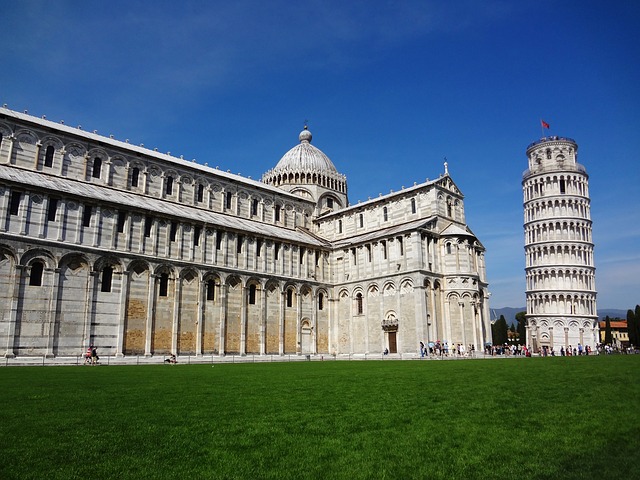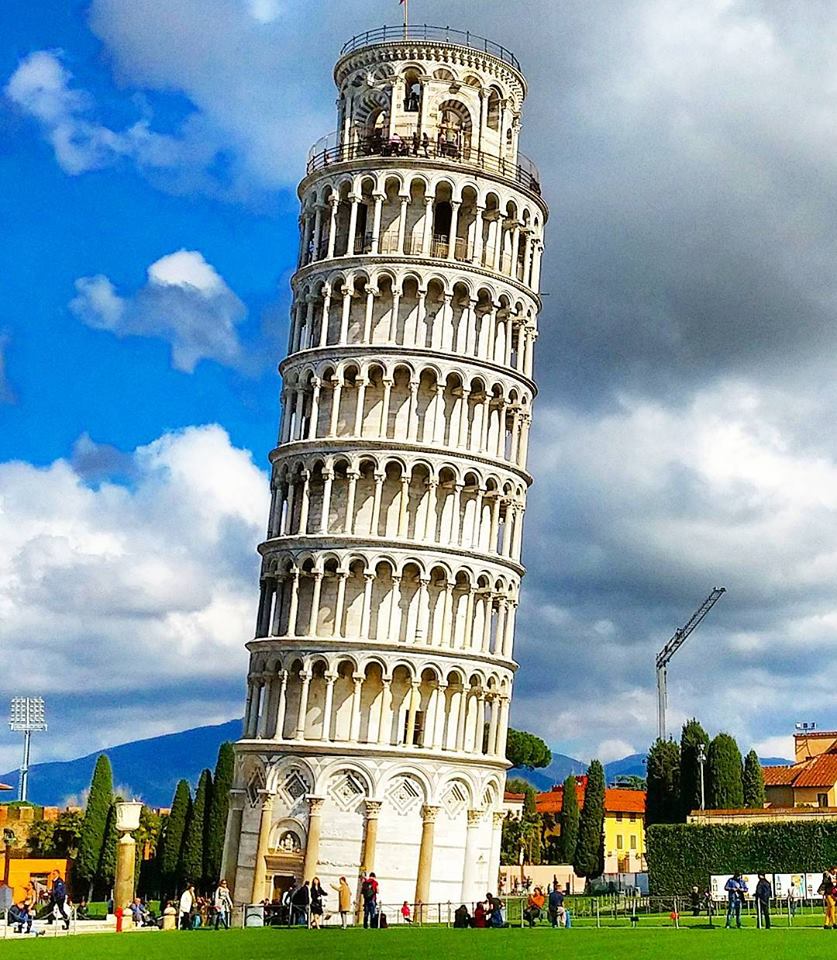Leaning Tower of Pisa
Contents |
[edit] Introduction
The Tower of Pisa, more popularly known as the Leaning Tower of Pisa, is the freestanding bell tower for the cathedral of Pisa, Italy. It is considered one of the most remarkable architectural structures from medieval Europe and is one of the most popular tourist attractions in Italy.
It is one of four buildings that encompass Pisa’s cathedral complex known as Campo dei Mircacoli (Field of Miracles), along with a baptistery, cemetery and the cathedral itself. Unusually for cathedrals of the period, the tower (or campanile) is some distance from the main building.
The construction of the tower began in 1173 and upon its completion around two centuries later, it was one of the tallest bell towers in Europe. Over the last 800 years there have been many attempts to correct the structural lean of the tower caused by unstable soil and foundation settlement. Extensive work was done at the end of the 20th century to stabilise the tower, and its lean was reduced to less than four-degrees, with it currently being more than 5 m (17 ft) off perpendicular.
[edit] Design and construction
The decision to build the tower was made with the intention of showcasing the city of Pisa as both powerful and influential. It was designed as a circular bell tower made of white marble in the medieval Romanesque style.
The architect who initially designed the tower remains a mystery, although the first construction phase is attributed to either Bonanno Pisano or Gherado di Gherado. The second phase of the construction was overseen by Giovanni Pisano and Giovanni di Simone. Tommaso Pisano managed the tower’s completion in 1399.
The tower has 8 storeys, including the chamber for the bells, and reached an original height of 60 m. The bottom storey consists of 15 marble arches, while the next six storeys each consist of 30, and the top bell chamber consists of 16. Two spiral staircases run up the inside of the tower. One consists of 294 steps while the other required two additional steps to compensate for the lean.
The lean only became apparent once construction of the third storey had been completed in 1178, as the shifting soil of clay, fine sand and shells began to destablise the foundations. A series of wars interrupted the construction for nearly a century which enabled the soil to consolidate and avoided the inevitable collapse had the tower been completed on schedule.
When construction was resumed, the architects tried to accommodate the lean by designing the additional storeys shorter on the uphill side but this failed to have any impact, instead the weight caused further sinkage. As the centuries went by it became clear that the tower was actually slowly falling over at a rate of 1-2 mm a year.
[edit] Post-construction
By the early 20th century, it became clear that the tower was inherently unstable and needed remedial work to try and prevent further leaning. The tower’s seven bells, which had been installed over the previous four centuries, were silenced, as it was thought that their movement while ringing could worsen the lean.
Many ideas were suggested for how to straighten the tower, including one which was to take it apart stone-by-stone and rebuild it somewhere else.
During the 1920s, the foundations were injected with cement grouting which helped to stabilise the tower in the short term, although it was clear that a more substantial solution would be needed in the future.
During the Second World War, the Allies came to believe that the tower was being used by the Nazis as an observation point. An artillery strike on the tower came close to being ordered by a US sergeant, but upon seeing the structure’s beauty he chose not to.
In 1983, the tower was apparently ‘straightened’ by a disaffected Superman in the film ‘Superman 3’.
In 1987, the cathedral site was listed as a UNESCO World Heritage Site. Despite this, Superman’s best efforts, and the tower’s popularity as a tourist attraction, there were growing concerns about its future.
[edit] Preventing collapse of the tower
Structural analysis showed the tower to be severely stressed at the level where the cross-section suddenly reduces. In 1989, work began to strengthen the structure and apply lead weights to the high side of the foundation. Following this, a series of ground anchors were installed around the north side of the tower to replace the lead weights.
These were, however, temporary measures and in 1990 the tower was officially closed as a team of engineers began a major straightening project. The lean was decreased by 44 cm to 4.1 m (13.5 ft) as a result of siphoning soil from beneath the foundations.
However, there was cause for alarm in 1995 when the tower leant 2.5 mm in one night. Engineers decided that instead of trying to work on the structure itself, they would seek solutions for the soil. They proposed an idea that had been raised in the 1960s, which was to extract soil from the high side of the tower, a technique which had been used to correct large differential settlement of a Mexican cathedral.
The trials proved successful and work commenced on boring 12 holes beneath the structure, extracting a total of around 37 m3 of soil. As the operation progressed, the lead weights were gradually removed and the tower responded as hoped, with the north edge settling 13 mm and the south side rising by 1.5 mm.
Work was completed and the structure reopened to tourists in May 2001. Without further excavation, the tower continued to straighten until a sensory analysis in 2008 found that the settlement had come to a stop with a total improvement of 48 cm (19 in.). Engineers have made a confident assessment that the tower will remain in a stable condition for at least the next 200 years.
[edit] Project data
- Address: Piazza del Duomo, 56126 Pisa, Italy
- Construction started: 1173
- Completed: 1399
- Height: 56.7 m (at highest side), 55.8 m (at lowest side)
- Storeys: 7 (8 including the bell chamber)
[edit] Related articles on Designing Buildings Wiki
- 7 Engineering Wonders of the world.
- 9 of the world’s most impressive structures.
- Building of the week series.
- Cracking and building movement.
- Defects.
- Dwarf gallery.
- Florence Cathedral.
- Hagia Sophia.
- Library of Celsus.
- Pantheon.
- Parthenon.
- Pulpit.
- Roman Colosseum.
- Sagrada Familia.
- Settlement.
- The history of fabric structures.
- Unusual building design of the week
[edit] External references
- Tower of Pisa - Official site
IHBC NewsBlog
Heritage Building Retrofit Toolkit developed by City of London and Purcell
The toolkit is designed to provide clear and actionable guidance for owners, occupiers and caretakers of historic and listed buildings.
70 countries sign Declaration de Chaillot at Buildings & Climate Global Forum
The declaration is a foundational document enabling progress towards a ‘rapid, fair, and effective transition of the buildings sector’
Bookings open for IHBC Annual School 12-15 June 2024
Theme: Place and Building Care - Finance, Policy and People in Conservation Practice
Rare Sliding Canal Bridge in the UK gets a Major Update
A moveable rail bridge over the Stainforth and Keadby Canal in the Midlands in England has been completely overhauled.
'Restoration and Renewal: Developing the strategic case' Published
The House of Commons Library has published the research briefing, outlining the different options for the Palace of Westminster.
Brum’s Broad Street skyscraper plans approved with unusual rule for residents
A report by a council officer says that the development would provide for a mix of accommodation in a ‘high quality, secure environment...
English Housing Survey 2022 to 2023
Initial findings from the English Housing Survey 2022 to 2023 have been published.
Audit Wales research report: Sustainable development?
A new report from Audit Wales examines how Welsh Councils are supporting repurposing and regeneration of vacant properties and brownfield sites.
New Guidance Launched on ‘Understanding Special Historic Interest in Listing’
Historic England (HE) has published this guidance to help people better understand special historic interest, one of the two main criteria used to decide whether a building can be listed or not.
"Conservation Professional Practice Principles" to be updated by IHBC, HTVF, CV
IHBC, HTVF, and CV look to renew this cross-sector statement on practice principles for specialists working in built and historic environment conservation roles.


















